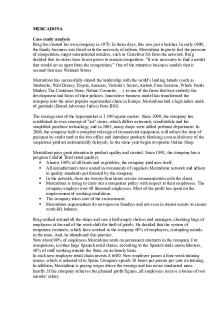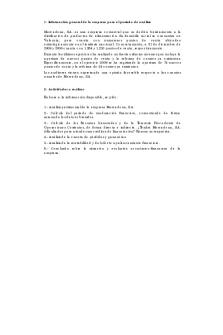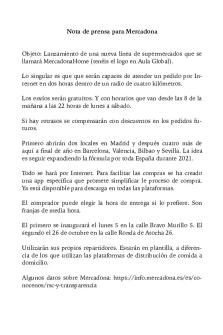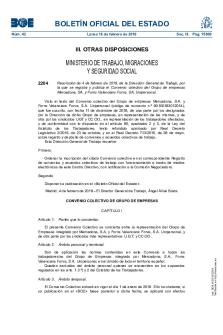Mercadona - case study PDF

| Title | Mercadona - case study |
|---|---|
| Course | Total quality management |
| Institution | Renmin University of China |
| Pages | 5 |
| File Size | 162.5 KB |
| File Type | |
| Total Downloads | 89 |
| Total Views | 149 |
Summary
Mercadona case study...
Description
MERCADONA Case study analysis Roig has created his own company in 1970. In those days, this was just a butcher. In early 1990, the family business was faced with the necessity of reform. Mercadona began to feel the pressure of competition, major international retailers, such as Carrefour SA from the network. Roig decided that its stores have lower prices to remain competitive. "It was necessary to find a model that would set us apart from the competition." One of the attractive business models that it seemed that uses Walmart Stores. Mercadona has successfully shared the leadership with the world's leading brands (such as Starbucks, Walt Disney, Toyota, Amazon, Victoria’s Secret, Airbnb, Four Seasons, Whole Foods Market, The Container Store, Nature Cosmetic, …) as one of the firms that best embody the development and focus of their policies. Innovative business model has transformed the company into the most popular supermarket chain in Europe. Mercadona had a high index mark of gratitude (Brand Advocacy Index) from BSG. The average area of the hypermarket is 1 300 square meters. Since 2000, the company has established its own concept of "air" stores, which differs extremely comfortable and the simplified purchase technology, and in 2005, many shops were added perfume department. In 2006, the company held a complete redesign of commercial equipment, will reduce the time of payment by credit card at the box office and introduce products blocking system (delivery of the suspicious product automatically delayed). In the same year began to operate Online Shop. Mercadona pays great attention to product quality and control. Since 1993, the company has a program Calidad Total (total quality). Almost 100% of all fruits and vegetables, the company produces itself. All manufacturers have united in community of suppliers Mercadona network and adhere to quality standards put forward by the company. In the network, there are twenty-four hours service communication with the client. Mercadona is trying to carry out a competent policy with respect to their employees. The company employs over 60 thousand employees. Most of the profit has spent on the improvement of working conditions. The company takes care of the environment. Mercadona supermarkets do not open on Sundays and not even in tourist resorts to ensure work-life balance. Roig walked around all the shops and saw a half-empty shelves and managers, checking bags of employees at the end of the work shift for theft of goods. He decided that the system of temporary contracts, which have worked in the company 60% of employees, corrupting morals in the team. And, he abandoned this practice. Now about 90% of employees Mercadona work on permanent contracts in the company. For comparison, in other large Spanish retail chains, according to the Spanish trade union laborers, 60% of staff working outside the State, on an hourly basis. In each new employee retail chain invests $ 6500. New employee passes a four-week training course, which is unheard of in Spain. Company spends 20 hours per person per year on training. In addition, Mercadona is paying wages above the average and has never conducted mass layoffs. If the company achieves the planned profit figures, all employees receive a bonus of two months' salary.
A few of Mercadona locations have nurseries to look after children and also free services like day care, food etc. Instead, Mercadona requires absolute loyalty of employees work. Sometimes they have to perform in stores other work not directly related to their regular duties. The assistance they provide in other areas of work, allows stores easier to adapt to changes in customer traffic.
Compare with competitors According to the Government of Spain, in 2006 the annual turnover of the food trade amounted to 67 billion 103 million euros. More than 80% of all grocery purchases in 2008 were made in supermarkets and hypermarkets. About 55% of all grocery purchases were made in the five biggest supermarket chains: Carrefour (23.7%), Mercadona (16%), Eroski (7.4%), Alcampo (6.1%) and El Corte Ingles (2.3%). (Supermercados, No Gracias, 2007). Survive in a crisis and succeed only those companies able to business in Spain, which are able to operate successfully in a competitive environment. Corporation Eroski Eroski has 97 hypermarkets, 20 hypermarkets cash & carry format, 482 EroskiCenter, 150 EroskiCity from Aragon to Galicia. Eroski is the leading food retailers in the Balearic Islands. Trade policy of the company can described in one phrase - "always the freshest and costeffective", according Ainary Sarraga (Eroski’s PR manager). This means offer the widest range of products at low prices throughout the year. Communication with customers - this is one of the most important aspects of the company's development. Quality control and maintenance of low prices paid most attention at Eroski. If the buyer can prove that the product does not match the quality, will receive a similar product plus a gift. Quality control is so scrupulous that the description of all the stages, can take a very long time. This policy is largely due to the history of the company. Most of the customers of the company are also its shareholders. Therefore, starting from its inception, the company lists 10% of its annual revenue in the Education and Development Fund. The company have still retains partial signs of the cooperative. All employees have their hands on the action. Now there are about 13 thousand of more than 32 thousand employees. The company's policy is to support national products and environmental protection. According to European notions of it is true social responsibility of companies. Eroski produces its own magazine on the consumer market - Consumer, but his edition is completely independent. El Corte Ingles (Hipercor) El Corte Ingles is the biggest department store group in Europe and ranks fourth worldwide. Hipercor is an up-scale chain of hypermarkets in Spain, belonging to the same group as El Corte Ingles. Competitive advantages Hipercor actively use the delivery service. Money for the goods when you return you can get in any store. Not only there, where it has purchased goods. The company is very picky in choosing suppliers. This applies to the formation of commodity matrix and issues Shopfitting. Prices of fresh products are reviewed every week.
Strengths
Weaknesses
Opportunities
Threats
Largest supermarket chain Good brand equity Strong delivery channels Freshness and cleanliness Strong, skilled workforce Home delivery Domestic market Does not need publicity No global presence Investment in research and development Limited loyalty Competitive market High loan rates and possible Improve quality Increase sales New products and service Global market Well-being environment Online shopping Increasing presence Economic crisis Lower investment n purchases Growing competition and lower profitability
Good quality products Strong presence in the Balearic Islands
Domestic market High growth rate High profitability and revenue Skilled workforce Reduced labor costs
Low/ minimal advertising Has not made an impact globally Competitive market Prices are higher than of competitors (Mercadona, Hipercor) Increase labor force Invest in advertising
Competitive market Investment in research and development
Competition from larger stores
Global market Growth rates profitability Growing demand New markets Income level is at a constant increase External business risks Price changes Unexpected problems Tax changes Growing competition and lower profitability
Mercadona stands out among its competitors striving for continuous improvement of quality of service. The leadership of Mercadona is based on solid pillars: motivated employees, excellent processes in order to deliver the highest quality products at the lowest prices, satisfied customers, satisfied society and creating value for its shareholders. Higher productivity allows Mercadona to control prices. Since 2009, Mercadona has lowered prices by 10%. This gives the company a sustainable competitive advantage. Since the main focus of all retail companies is the number of produce they sell, as opposed to their balance sheets, Mercadona has shown that even during crisis it is still possible to be a leader amongst supermarkets thanks to good consumer relations. The number of kilos and liters sold rose from 8,000 in 2009 to 9,101 in 2011 (Mercadona Report). This is opposite of supermarkets like Carrefour, which has witnessed a slump in its produce (Reuters). In a period of great difficulty, Mercadona has managed to grow and generate financial and social wealth. The work force has been maintained and there was an increase of 500 employees in 2009. The Management is not confused and is characterized by innovation in achieving cost reduction with the highest quality, continue to invest in human resource issues (training, incentives), reduction of benefits to lower selling prices more and strengthen long-term relations with suppliers.
The challenges are to maintain leadership and continue to innovate to keep customer love and move opposite of what competitors do. For example, companies such as Bon Preu have reacted to the reduction of Mercadona suppliers to the extent of increasing the number of brands for clients so they have more choices. Suggestions for further improvement: Parking and corridors good connected Positions of the corridors strategically Donate more food as social work Enter the global market Improving online purchase Continue to expand and improve its network of stores in order to fulfil its goal of offering its customers the best possible shopping experience The launch of more personalized system for orders and the implementation of tools to facilitate coordination with suppliers More communicated with The Boss (as at Mercadona call the customers) – active using social network (Twitter, Facebook, YouTube, Periscope, …) Introduce technology to manage the processes in real time Share and consolidate its competitive advantage over competitors To increase sale by launching new products, optimizing packaging and streamlining their selections Customers prefers good quality food in minimum short time with maximum freshness so lot of growth opportunity for this industry Other companies such as Carrefour and Alcampo have initiated major advertising campaigns in order to convince customers that their price targets are lower than those of Mercadona. Eroski and Caprabo have continued using competitive intelligence as to derive the most information about its customers to increase loyalty. Another challenge is the internationalization of Mercadona. To do this, it will be essential to continue working as hard as usual and think what customers like as they go, if you lose the competitive advantage. Total quality management can be defined as a means of seeking excellence in all functions of business in order to prevent possibilities of errors or mistakes and to create optimal customer satisfaction Quality is used a strategic weapon where companies use to compete within the current markets. Quality pleases the consumers who are the most important people for any business whether in service sector or deals with production of goods. It is apparent that techniques of TQM are important for a company to succeed and remain competitive in the marketplace. The techniques of TQM are applied on every essential function of a business including, Human Resource Management, SCM, CRM, and marketing.
References: FOOD WASTE, An analysis of the retail sector (http://api.eoi.es/api_v1_dev.php/fedora/asset/eoi:80144/EOI_FoodWasteIMSD_2012.pdf ) Mercadona – Innovative HR Practices for better store performance, Jan 17, 2011 (http://www.casestudyinc.com/mercadona-innovative-hr-practices-retailing) Mercadona: Adapting the business model in years of recession, Oriol Amat, UPF Josep Francesc Valls, ESADE (http://www.econ.upf.edu/docs/case_studies/51en.pdf) Mercadona annual report 2013 (https://www.mercadona.es/corp/alehtml/memoria2013.html#menu13) How the smartest companies invest in employees to lower costs & boost profits, Zeynep Ton, MIT Sloan School of Management (https://books.google.kz/books? id=kJeHAgAAQBAJ&printsec=frontcover&hl=ru#v=onepage&q&f=false)...
Similar Free PDFs

Mercadona - case study
- 5 Pages

Mercadona memoria anual 2017
- 112 Pages

Trabajo estrella- Mercadona
- 16 Pages

Caso mercadona - Nota: 10
- 4 Pages

Tesco-Case-Study - Case Study
- 3 Pages

CASO Mercadona Práctica
- 13 Pages

Caso 1 Mercadona
- 5 Pages

Mercadona Home - Apuntes 3
- 1 Pages

RSC de Mercadona.
- 1 Pages

Case 7 - Case Study
- 1 Pages

Case 9 - Case study
- 6 Pages

Case-7 - case study
- 5 Pages

Tesla Case - CASE STUDY
- 22 Pages

CASE Accenture - case study
- 3 Pages
Popular Institutions
- Tinajero National High School - Annex
- Politeknik Caltex Riau
- Yokohama City University
- SGT University
- University of Al-Qadisiyah
- Divine Word College of Vigan
- Techniek College Rotterdam
- Universidade de Santiago
- Universiti Teknologi MARA Cawangan Johor Kampus Pasir Gudang
- Poltekkes Kemenkes Yogyakarta
- Baguio City National High School
- Colegio san marcos
- preparatoria uno
- Centro de Bachillerato Tecnológico Industrial y de Servicios No. 107
- Dalian Maritime University
- Quang Trung Secondary School
- Colegio Tecnológico en Informática
- Corporación Regional de Educación Superior
- Grupo CEDVA
- Dar Al Uloom University
- Centro de Estudios Preuniversitarios de la Universidad Nacional de Ingeniería
- 上智大学
- Aakash International School, Nuna Majara
- San Felipe Neri Catholic School
- Kang Chiao International School - New Taipei City
- Misamis Occidental National High School
- Institución Educativa Escuela Normal Juan Ladrilleros
- Kolehiyo ng Pantukan
- Batanes State College
- Instituto Continental
- Sekolah Menengah Kejuruan Kesehatan Kaltara (Tarakan)
- Colegio de La Inmaculada Concepcion - Cebu

